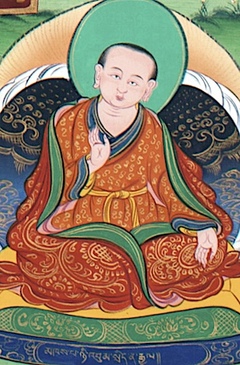Zhang Nyibum Biography
Literary Genres › Biography | Collections & Cycles › Nyingtik Yabzhi › Vima Nyingtik | Tibetan Masters › Longchen Rabjam | Tibetan Masters › Nyima Bum

Khepa Nyima Bum
Courtesy of Tertön Sogyal Trust
Further information:
- Treasury of Lives Author Bio
- BDRC Author Profiles: P1583 P633
Biography of Zhang Nyibum
from the Vima Nyingtik[1]
Embodiment of the gurus of the supreme immaculate lineage,
Sovereign of all scriptural collections, heir of victorious ones—
To the indisputable guru, who shines the sunlight of wisdom
On all beings everywhere, I bow down in reverence.
What follows is a brief profile of the one called Zhang Nyima Bum, who was prophesied in the root Reverberation of Sound tantra as an emanation of Vajrapāṇi. He was born as the son of the one whose name is difficult to utter, Gyalwa Zhangtön, and Gyalmo Yang.[2] At the child’s birth, his father gave him his name, saying, "You will be like the sunlight that dispels the darkness of ignorance among all beings, so we will call you Nyima Bum—Hundred Thousand Suns."
From Nyibum’s third year, he practised the sādhanas of Kīlaya and Yangdak from Sopo Gyatön Lungdrowa;[3] he received blessings and eliminated obstacles. From his fifth year to his seventh or eighth year, he received from his father all the empowerments and instructions of the unsurpassable secret teachings and the full reading transmission for the Seventeen Tantras. His father then passed away during Nyibum’s ninth year.
Zhang Yudrakpa was invited around this time. He passed on the extensive, intermediate and brief scriptures,[4] and, in offering such sacred words, brought peace and happiness to the land.
From his tenth to his fifteenth years Nyibum gave thorough explanations of the root Reverberation of Sound tantra and the Seventeen Tantras. At his investiture, he gathered disciples and offered them explanations of the tantras and related instructions, much to the amazement of everyone present, who developed faith in him as a result. During his eighteenth year he received the higher empowerments in the presence of the Lobpön.[5]
In his twentieth year, he went to see the lama Ngok Gyaltsa Dorje Senggé and received tantras and instructions related to the Sarma tradition of mantra. In his twenty-second year he took Jomo Gyagar as his wife. In his twenty-seventh year he went to see Drakpa Gyaltsen of the Sakya Khön family and Lama Taksowa and received instructions on the Three Continua and the Malgyo tradition of Cakrasaṃvara.
In his twenty-ninth year Nyibum took Jomo Seng-gyen as his wife. In his thirtieth year he received the Acha tradition of Cakrasaṃvara, the Ra tradition of the Noble Goddess (Tārā), the Protector Jarokma and the teachings of the Tsalpa,[6] from Kyitön Drakpa of Kharak Böndruk. In addition, he received multiple instructions from a number of other learned and accomplished teachers and reached an advanced level of realization. He also gave numerous explanations of the tantras, guiding instructions and so on, and thereby brought all his students to spiritual maturity and liberation.
He demonstrated passing beyond on the eighth day of the Month of Miracles in his fifty-sixth year, and his corpse was cremated.[7] Five types of relics, in different colours, appeared in the ashes, such as śarīram, nya-rīram, chu-rīram, and peñtsa-ram,[8] and the great Lama Nyibum vanished into absolute space.
Kyema kyihü!
May the precious one named Nyima, the Sun,
Look with eyes of wisdom, pure and bright,
At the dense dark of saṃsāra’s six classes,
And, with the lantern of five-coloured light,
Illuminate in a mere instant
This darkness, so empty and intense.
It is complete.
| Translated by Adam Pearcey with the generous support of the Tsadra Foundation, 2024.
Bibliography
Tibetan Edition
"zhang nyi 'bum gyi rnam thar" In snying thig ya bzhi. 13 vols. Delhi: Sherab Gyaltsen Lama, 1975. Vol. 6: 416–420 (2 folios)
Secondary Sources
Achard, Jean-Luc. “Zhang Nyi ma 'bum (1158–1213) et le développement des sNying thig au 12e siècle”, Revue d’Etudes Tibétaines, no. 44, Mars 2018, pp. 231–257.
Dudjom Rinpoche. The Nyingma School of Tibetan Buddhism. Translated by Gyurme Dorje and Matthew Kapstein. Boston: Wisdom, 1991.
Leschly, Jakob. "Nyima Bum," Treasury of Lives, accessed February 09, 2024, https://treasuryoflives.org/biographies/view/Nyima-Bum/8912.
Martin, Dan. "Pearls from Bones: Relics, Chortens, Tertons and the Signs of Saintly Death in Tibet" in Numen, Vol. 41, No. 3 (Sep., 1994), pp. 273–324
Nyoshul Khenpo. A Marvelous Garland of Rare Gems. Translated by Richard Barron. Junction City, California: Padma Publication, 2005.
Version: 1.0-20240219
-
The precise authorship is unclear. Although the text appears in a recent edition of the collected writings of Longchen Rabjam, it does so only because the entire Nyingtik Yabzhi corpus is included. Likewise, it is included here within the Longchen Rabjam section purely for the sake of convenience. Jean-Luc Achard discusses the biography’s authorship (without settling on any definitive attribution) in his 2018 article, which also includes a French translation of the text. ↩
-
Here a note says that while she was pregnant his mother dreamt of the dawning of multiple suns, and that when she reported this to her husband he said, "Have no doubts. This is a sign that the child will bring benefit to many sentient beings through the unsurpassable secret teachings." ↩
-
As Achard notes, the identification of this figure is unclear. ↩
-
i.e., Prajñāpāramitā ↩
-
The text says simply lobpön (slob dpon)—ācārya in Sanskrit—without specifying the name of the teacher. Jean-Luc Achard wonders whether this might refer to the Sakya patriarch Sönam Tsemo (1142–1182), who was often called Lobpön Sonam Tsemo and would have been around 34 years old at this time. ↩
-
i.e., the Tsalpa Kagyü established by Zhang Yudrakpa (1123–1193). ↩
-
The 1975 edition omits sbyangs pa. ↩
-
See Martin, "Pearls from Bones: Relics, Chortens, Tertons and the Signs of Saintly Death in Tibet", pp. 281–282. ↩